
I help organise Deliver Sessions meetup, and in February 2025 we had our first meetup of the year at Booking.com’s office in Castlefield. This is on the site of the old Granada TV Studios, where the Beatles made their first TV appearance. I could write a whole post about these studios (including how they briefly had the world’s first “flying” rollercoaster), but I should get back to the meetup…
This time, we’ve got some advice on topics lots of people struggle with – first up, what a product strategy actually is and what makes it useful. If that makes you decide you’d like to talk about changing anything at work, it might feel daunting to bring up – hopefully our second talk, on psychological safety, will give you tools to approach this and any other topics you worry about.
WTF is a Product Strategy anyway?
“Your CEO thinks it’s a pitch deck. Your engineering team think it’s a plan to manage tech debt. You know you should have one yet no-one can agree on what one really is.
“Holly will share an unfiltered account of the highs and lows of establishing a product strategy. She’ll share real world experiences of what to do when the business strategy is simply to make more money and the CEO changes their mind from one week to the next.
“As product people, we know we should have a product strategy. We love a framework, yet, when we talk about product strategy, it quickly gets vague and complex.
“This talk will help you understand how to turn a bunch of disconnected strategic thinking into a tangible strategy that everyone can align to.”
– Holly Donohue (Fractional CPO)
Lots of orgs struggle with the idea of strategy – Holly gave familiar examples of cases where people put every unrelated thing they’re planning to do anyway up on a board, label it all top priority, and call that their strategy. We can do better!
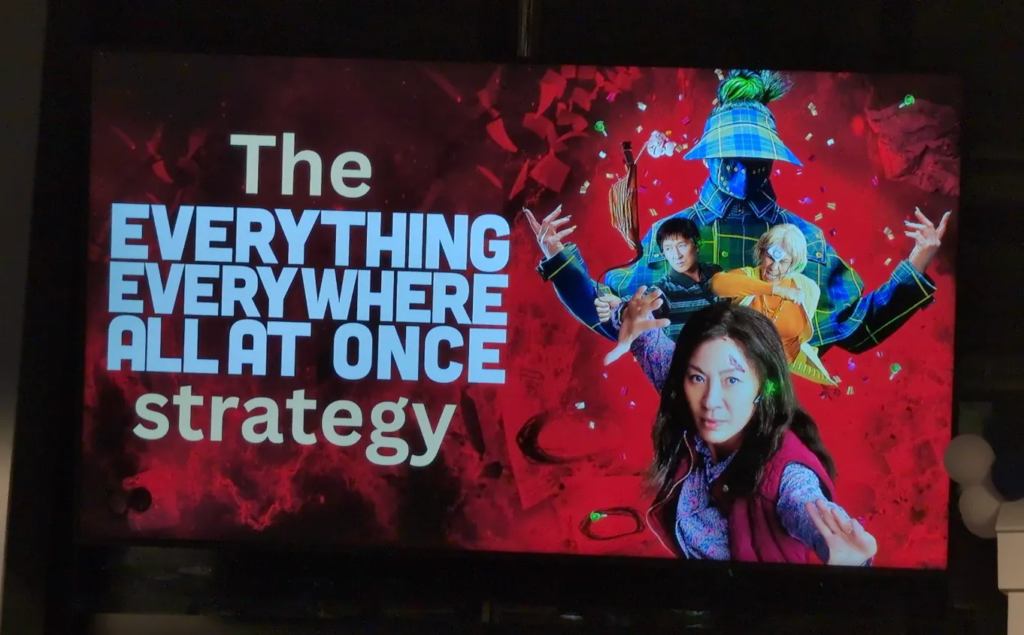
Holly quoted Richard Rumelt’s “Good strategy / bad strategy” book: “A product strategy is a pathway to significantly higher performance”, and should be about focus, differentiation, and being outcome-based. She also highlighted that OKRs (Objectives and Key Results) are not a strategy, even though orgs try to use them that way. OKRs can be very useful, but they don’t fill this strategy gap, you need something else. I liked these themes – I’ve written about something similar in a post about OKRs (including recommending that same book!)
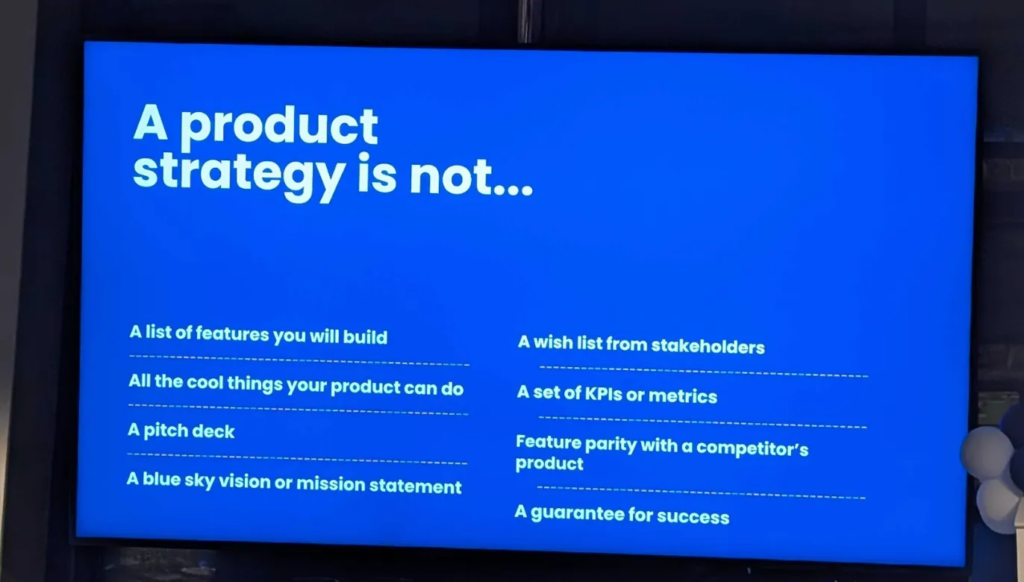
Holly shared lots of examples of effective strategies, including companies that rethought the market they were trying to compete in. The Nintendo Wii ignored the high processing power and deep, complex gameplay that other consoles were trying to outdo each other on, and found huge success with simpler games, a novel interface, and a huge untapped market of people who had never played on a gaming console before.
She mentioned ideas from the “Blue ocean strategy” book by Chan Kim and Renee Mauborgne: Which ocean would you like to swim in?
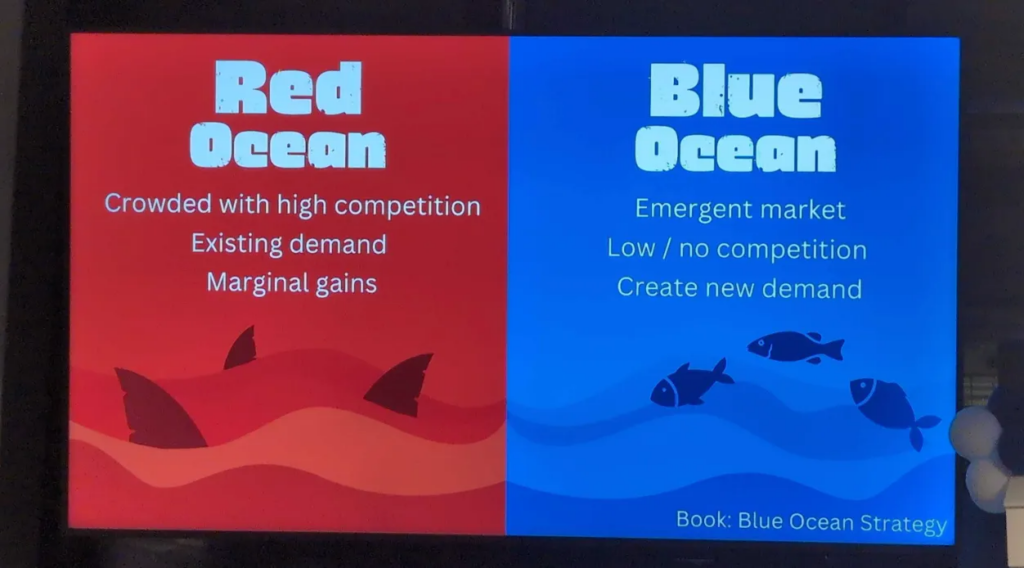
There was lots more good advice in the talk:
- You still need outputs, they’re not a bad thing… sometimes people think you can’t talk about them at all. They’re important, but they need to be in service of achieving an outcome, and that’s too often missed. We had more on this theme in Robyn Slater’s Deliver Sessions talk.
- To help write your strategy, you have lots of choices: Business model canvas, lean canvas, too many more to count… but the template you use doesn’t matter that much, it’s the thinking you put into it. Worry less about finding the perfect template.
- However, one approach Holly does use a lot is the SWAG (Stupid Wild-Assed Guess) strategy format from Ed Biden. Quickly put your best guess in these 7 categories, then show it to lots of people in your org. They’ll tell you where your wrong, start discussing opinions with others, and get to the “useful conversations” part much faster.
With all things strategy: you can’t get to 100% confidence in things, there’s never a perfect answer. Holly recommends you test the riskiest areas and do your best.
Psychological safety – The link between speaking up, complexity and high performing teams
“Psychological safety is essential for high-performing engineering teams, yet it’s often misunderstood. In this talk, I’ll share my journey to understand this foundational concept and how we can enhance it.
“Over the past five years, I’ve helped teams improve their products and services, often stepping in to resolve testing challenges. But as we dug deeper, the root issue was rarely testing itself—it was poor communication. Team members hesitated to speak up, allowing small issues to fester and escalate, often mistaken for technical complexity.
“In this talk I’ll explore why people hold back, how this compounds problems in complex environments, and why our usual fixes might be making things worse. We’ll reframe psychological safety, tackle misconceptions, and discuss practical ways to create environments where people feel safe to speak up.”
– Jitesh Gosai (principal tester)
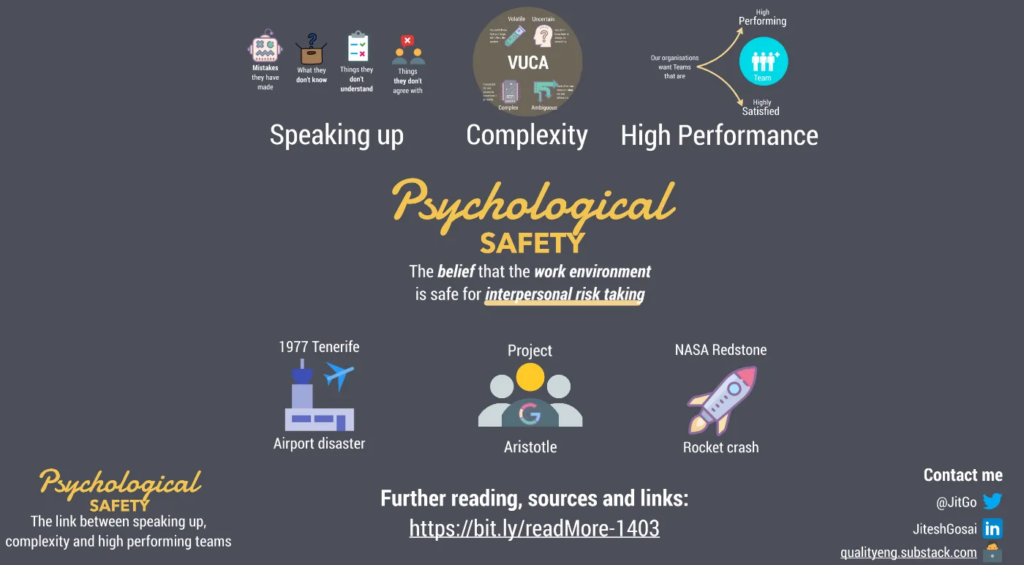
Jit’s talk started with several examples of being hesitant to speak up in the moment had significant consequences.
NASA Redstone rocket crash: Looking into what caused it, an engineer wondered if it was him – he’d touched a circuit with a screwdriver by mistake, seen a spark, tested and it seemed fine. He could have stayed quiet… but brought this up, people investigated, and yes that was the cause.
He was given a bottle of champagne and thanked profusely for his candour. How common would that reaction be in most organisations? And how much benefit might there be in building an environment where more of this kind of speaking up happens?
Dr Amy Edmondson defines psychological safety as “the belief that the work environment is safe for interpersonal risk taking”. A good place to learn more about this term’s origins and implications is her book “The fearless organisation” (summary notes from Sophie Weston).
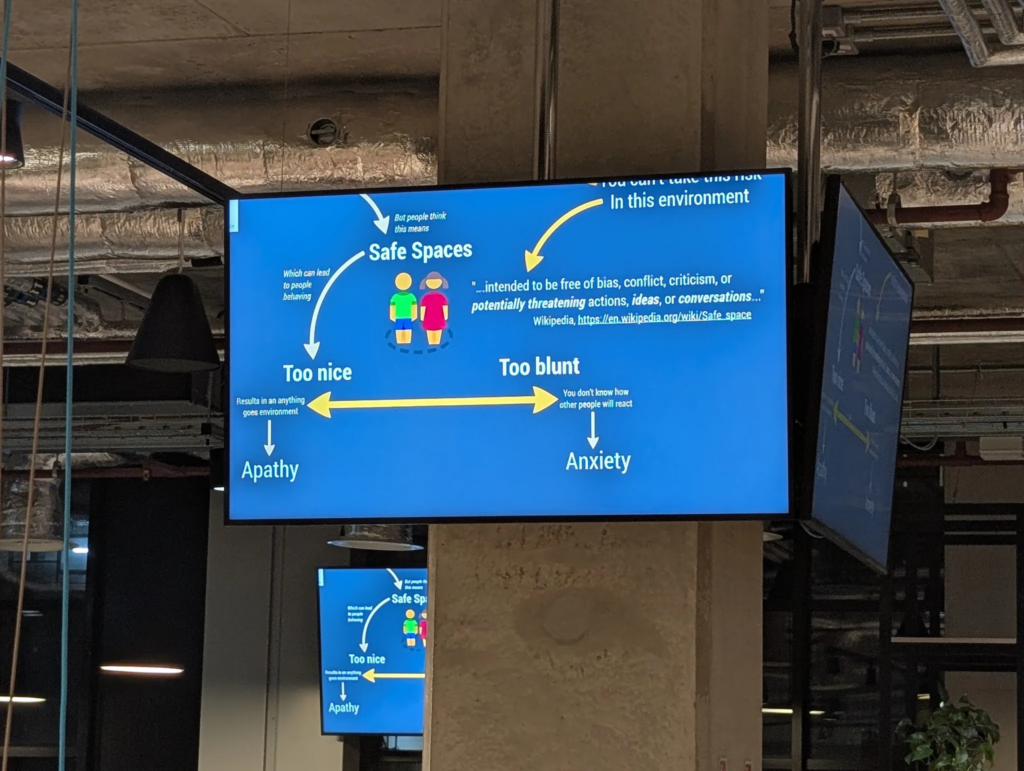
Jit’s role is helping teams improve software quality. A huge part of that: can people bring up things they think – but aren’t sure – might be important? In most teams, some things feel easy to share, while others are harder. If people can’t share things they’ve done wrong, your team can’t learn from failure effectively. This seriously hurts performance.
You can counteract this by having teams who focus on learning and continuously improving. This needs to happen while you’re working. Training courses are great, but the bulk of this useful learning comes from doing real work with others.
When Jit mentioned psychological safety, people would nod and say that they know what that is. What most people meant was: I can guess, based on those words. Thinking of it as “safe spaces” misses the point. Psychological safety is about taking risks, and moving out of your comfort zone. The skills and behaviours to encourage it are all learnable, and you can work on them whether you’re a senior leader or a peer on a team.
I don’t need to share too many notes from Jit’s talk as he’s done a great job of that himself, with a page of key points, further reading links, and a copy of his impressively detailed presentation diagram. And you can hear more from Jit on his newsletter: https://qualityeng.substack.com.
More from the meetup
If you’re interested in attending (or talking at) Deliver Sessions in Manchester, follow the meetup here: https://deliver-sessions.eventbrite.com. To read more about past sessions, see all the Deliver Sessions posts.